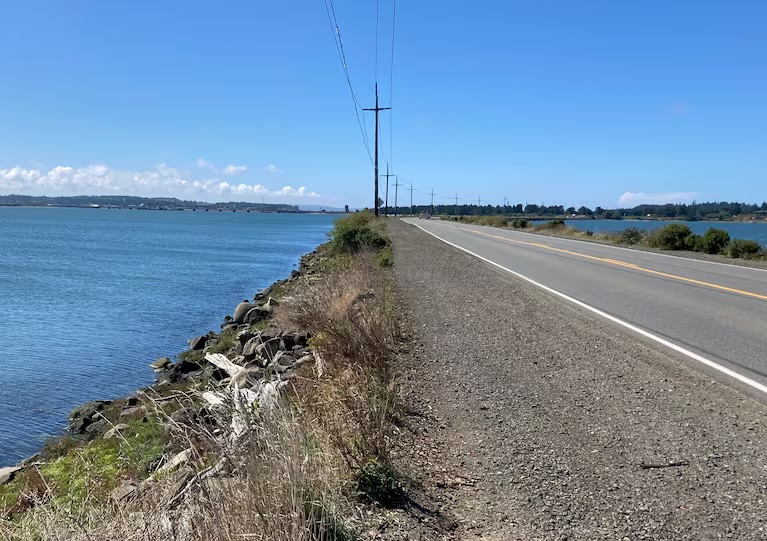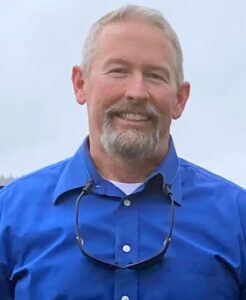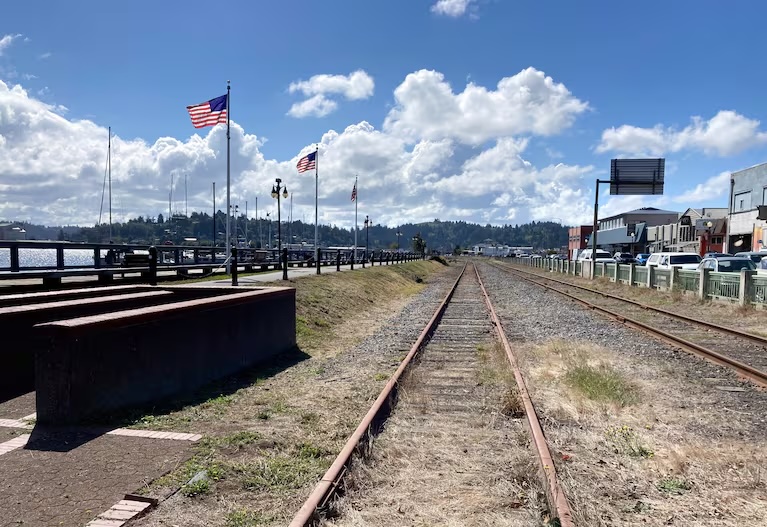
By KYRA BUCKLEY/Oregon Public Broadcasting
COOS BAY — For decades, it seemed like Oregon’s south coast city of Coos Bay couldn’t catch a break — at least not economically.
The timber industry mostly fled, taking hundreds if not thousands of jobs with it. Fishing and tourism continue to be vital to the area’s financial health, but no economic driver of the same caliber as timber has emerged. Meanwhile, projects – such as a controversial liquefied natural gas export terminal – have been proposed and then thwarted.
“I absolutely love this place,” Melissa Cribbins, an attorney and former county commissioner born and raised in Coos Bay, told OPB. “I love the idea that more economic development helps the citizens here and gives us an opportunity to show the rest of the world what we know about it – which is this is an amazing place, with terrific natural resources, a great place to live, a great place to raise a family, and there’s so many people that would like to be here.
“But they just need a job.”
That’s why, a few months ago, Cribbins signed on to head a project she and others hope will bring 2,500 permanent jobs and 2,500 temporary construction jobs to the area — the Pacific Coast Intermodal Port project.
 It’s a wonky name for a $2.3 billion project that would create a massive deep-water terminal where large cargo ships drop off 20 to 40-foot-long shipping containers full of goods from across the Pacific Ocean. The only other such service in the state is more than 200 miles away in Portland.
It’s a wonky name for a $2.3 billion project that would create a massive deep-water terminal where large cargo ships drop off 20 to 40-foot-long shipping containers full of goods from across the Pacific Ocean. The only other such service in the state is more than 200 miles away in Portland.
In Coos Bay, the overseas goods would then travel by rail to cities like Eugene, and onward to stores or other parts of the country. Meanwhile, containers full of lentils, hay, animal feed, wood products and other Oregon agricultural goods would be loaded from rail cars onto the large cargo ships headed for other countries. While the project still has a ways to go, last week it won $29 million in federal funding for planning upgrades to the railroad. That money is on top of a recent $25 million award for planning work on the channel.
And beyond the potential jobs the terminal would bring, proponents hope it can usher in a wave of investment and development to grow economic opportunities for the more than 60,000 people living in Coos County.
“The thing that people often miss about economic development, they might think, ‘Well, I’m retired, I don’t need a job,’” Cribbins said. “But what they don’t realize is there’s so much incidental business that comes from having something like this Port facility.”
Cribbins said if the shipping container terminal comes to fruition, it could also create close to 7,000 indirect jobs.
Why shipping containers
The area was a bustling timber shipping hub in the mid-1980s, with hundreds of cargo ships visiting each year, according to Mike Dunning, the chief operating officer for the Port of Coos Bay.

“At the height of the timber industry, there were about 350 vessel calls in Coos Bay, deep draft vessels,” said Dunning, who joined Port staff 12 years ago after two decades with the U.S. Coast Guard. “Today we see about 60, maybe 70 on average every year. And again, that’s from the decline of the timber industry – this community suffered greatly when that happened, and we’ve got to bring something here to change that and bring those jobs back into the community.”
Before the Covid pandemic hit, a Canadian oil and gas transport company had wanted to build an export terminal for liquefied natural gas. The terminal would have been in a similar location as the proposed shipping container terminal.
The project, known as Jordan Cove, also included building a more than 200-mile pipeline to transport gas to the terminal, where it would be cooled to liquid and then loaded onto ships headed overseas.
But winning support, funding and permits for the Jordan Cove project was an uphill battle from the beginning. The project also faced steep opposition from potentially affected landowners and from environmental advocates, and it was eventually canceled.
“We were at about 90% design just before Covid in 2019, when that project pulled out and went away,” Dunning said. “Shortly after that, NorthPoint Development came forward with the idea of putting a container facility on the north spit.”
NorthPoint Development would be responsible for running the shipping container terminal, while the Port remains the land and rail owner. As proposed, the terminal could serve around 300 ships per year.

The many hurdles
Dunning is confident the area can handle the increase in cargo ship activity because of the hundreds of ships that used to flock to the area each year for timber. But cargo ships are larger than they were in the ’80s, and the channel from the Pacific Ocean to Coos Bay’s terminal needs deepening – an expensive, lengthy and environmentally fraught undertaking.
The shipping container terminal may not face the same fierce opposition as the liquefied natural gas export terminal – but there is still resistance. Environmental advocates in Oregon have long opposed the act of dredging, needed to deepen the channel, while some in the commercial or recreational fishing industry could raise concerns about the impact on the ocean ecosystem as the project moves forward.
A 2023 bill in the Oregon legislature granted land-use exceptions to a handful of ports in the state, including Coos Bay. It was opposed by various conservation and environmental groups, dozens of which testified against the bill saying proposed projects should go through the regular land-use permitting process.
“Dredging the bay beyond the current channel will presumably result in the destruction of eelgrass beds, mudflats, and marshes, perhaps destroying habitat for salmon and Dungeness crabs, the staples of the local fishing industry, and other species of interest, including some that are listed under the Endangered Species Act,” wrote members of the Oregon Shores Conservation Coalition in its testimony against the bill.
State lawmakers ultimately approved the legislation, creating an easier path for the Port in terms of winning state approval. But as the project progresses, Dunning said they will have to work with multiple federal agencies to get the appropriate permits to ensure the project’s environmental safety.
And two major hurdles remain: securing the rest of the funding needed, and getting the green light from all involved agencies.
Money, money, money
To start the channel deepening design, engineering and permitting, Dunning said the Port has been using $60 million allocated from the state legislature nearly two decades ago for a since-canceled proposal.
Dunning said the work done on previous proposals helped the Port complete around 90% of the needed environmental reviews for the first leg of the terminal’s development.
But to continue the estimated $2.3 billion project, the Port needs a healthy-sized investment. Leaders are looking for that funding mostly in the form of federal grants – and so far it’s been a mixed bag.
In 2023, the project did not get the $900 million Mega Grant the Port applied for with the U.S. Department of Transportation. However, the terminal has gotten smaller nods of approval from the federal government. The Port was awarded $25 million that it will use to continue the needed environmental reviews and obtain permits from the agency’s Nationally Significant Multimodal Freight and Highways Projects grant program. And on Friday, the feds followed up with a $29 million award for planning upgrades to the Port’s rail line.
According to Dunning, the project has three components that need to go through the engineering, design and permitting process — the widening of the channel in Coos Bay, building the terminal and rail yard on the dock, and upgrading the more than 100-mile rail corridor from Coos Bay to Eugene.
That planning process is nearly finished for the channel deepening, he said.
“So there’s not a lot of funding needed for that,” Dunning said. “But for the other two legs, there’s a lot of work that’s got to be done.”
The challenges of development
The project at the Port is ambitious, expensive, involves multiple state and federal agencies, and will take years to construct. The payoff could be huge – but many community members aren’t waiting for a major economic jumpstart. Instead, parts of Coos Bay have been leaning into tourism, fishing and the area’s culture and history when looking at ways to develop.
The Coquille Tribe owns and operates a number of businesses in the area. That includes the Mill Casino, where the tribe is investing in a distillery that could create 30 permanent jobs, according to Margaret Simpson, chief executive officer of the Coquille Economic Development Corporation.
Simpson keeps her focus on tribal projects and said she hasn’t heard a lot of community responses to the proposed shipping container terminal. But she’s following it because if the project comes to fruition it would affect Coquille businesses and tribal members.
“We need to be prepared for it,” Simpson said. “Whether that’s going to be an influx of people that are coming in to work – and what we’re going to do with a situation that might further compromise our limited housing in the community and how that might affect our team members – or if we’re going to have additional guests and volume that we’ll be servicing and catering to, we’ve been watching it.”
Developer Greg Drobot says the limited amount of housing is a complicated barrier to growth in Coos Bay.
“Every business owner I talk to, the hospitals and clinics and even retail, they said ‘We’d hire more people, but there’s nowhere for them to live’,” Drobot, who is also the founder of Bandon-based Face Rock Creamery, said. “Having that lack of housing, it’s a huge headwind for future economic development. But then the problem is, it’s still a lower income area.”
Drobot spearheaded a number of development projects in the area, including a mixed-use retail, dining and recreation area along the waterfront. The next project he’s planning is a housing subdivision as a way to alleviate the housing crunch.
Regarding the Port’s shipping container terminal, Drobot’s cautiously optimistic. It’s still a big project that relies on funding the community has little control over, he said, making it hard to get too excited about.
But if the Port project does come through, he said it would “turbocharge” the work he’s doing.
“I’m not relying on any of that for anything that I’m working on,” Drobot said. “But it would be massive. I mean, there are thousands of jobs potentially coming to the area – and good paying jobs. And I think we’re starting to get the infrastructure in place to support something like that.”
- This story originally appeared Oct. 25, 2024 on Oregon Public Broadcasting.



Comment Policy